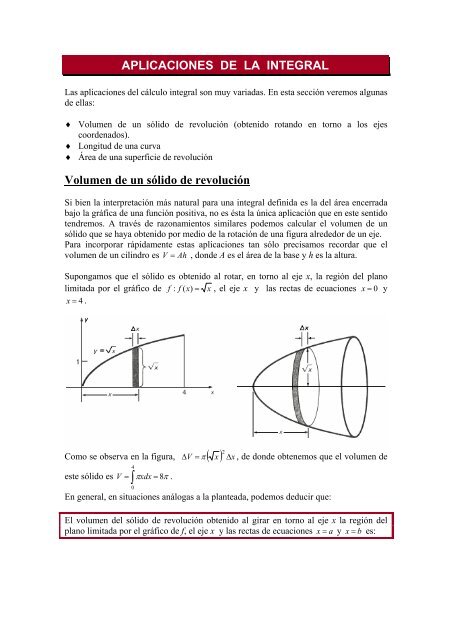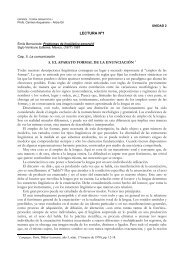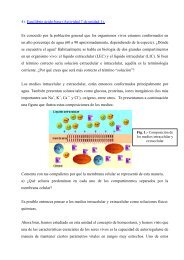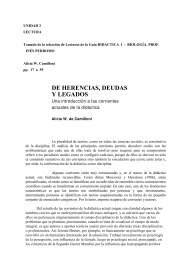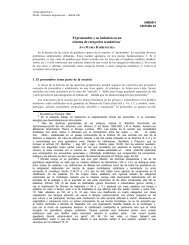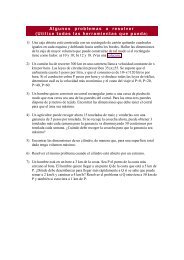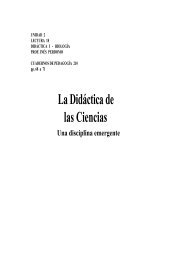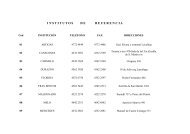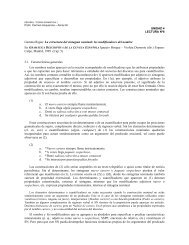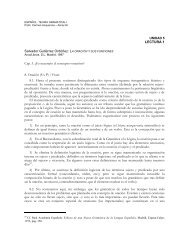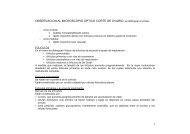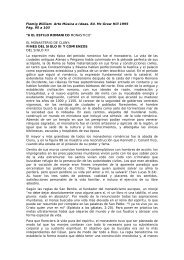APLICACIONES DE LA INTEGRAL Volumen de un sólido de ...
APLICACIONES DE LA INTEGRAL Volumen de un sólido de ...
APLICACIONES DE LA INTEGRAL Volumen de un sólido de ...
You also want an ePaper? Increase the reach of your titles
YUMPU automatically turns print PDFs into web optimized ePapers that Google loves.
<strong>APLICACIONES</strong> <strong>DE</strong> <strong>LA</strong> <strong>INTEGRAL</strong><br />
Las aplicaciones <strong>de</strong>l cálculo integral son muy variadas. En esta sección veremos alg<strong>un</strong>as<br />
<strong>de</strong> ellas:<br />
♦ <strong>Volumen</strong> <strong>de</strong> <strong>un</strong> sólido <strong>de</strong> revolución (obtenido rotando en torno a los ejes<br />
coor<strong>de</strong>nados).<br />
♦ Longitud <strong>de</strong> <strong>un</strong>a curva<br />
♦ Área <strong>de</strong> <strong>un</strong>a superficie <strong>de</strong> revolución<br />
<strong>Volumen</strong> <strong>de</strong> <strong>un</strong> sólido <strong>de</strong> revolución<br />
Si bien la interpretación más natural para <strong>un</strong>a integral <strong>de</strong>finida es la <strong>de</strong>l área encerrada<br />
bajo la gráfica <strong>de</strong> <strong>un</strong>a f<strong>un</strong>ción positiva, no es ésta la única aplicación que en este sentido<br />
tendremos. A través <strong>de</strong> razonamientos similares po<strong>de</strong>mos calcular el volumen <strong>de</strong> <strong>un</strong><br />
sólido que se haya obtenido por medio <strong>de</strong> la rotación <strong>de</strong> <strong>un</strong>a figura alre<strong>de</strong>dor <strong>de</strong> <strong>un</strong> eje.<br />
Para incorporar rápidamente estas aplicaciones tan sólo precisamos recordar que el<br />
volumen <strong>de</strong> <strong>un</strong> cilindro es V = Ah , don<strong>de</strong> A es el área <strong>de</strong> la base y h es la altura.<br />
Supongamos que el sólido es obtenido al rotar, en torno al eje x, la región <strong>de</strong>l plano<br />
limitada por el gráfico <strong>de</strong> f : f ( x)<br />
= x , el eje x y las rectas <strong>de</strong> ecuaciones x = 0 y<br />
x = 4 .<br />
Como se observa en la figura, ΔV<br />
= π ( x ) Δx<br />
este sólido es V =<br />
∫<br />
πxdx = 8π .<br />
4<br />
0<br />
2<br />
, <strong>de</strong> don<strong>de</strong> obtenemos que el volumen <strong>de</strong><br />
En general, en situaciones análogas a la planteada, po<strong>de</strong>mos <strong>de</strong>ducir que:<br />
El volumen <strong>de</strong>l sólido <strong>de</strong> revolución obtenido al girar en torno al eje x la región <strong>de</strong>l<br />
plano limitada por el gráfico <strong>de</strong> f, el eje x y las rectas <strong>de</strong> ecuaciones x = a y x = b es:
V = π<br />
b<br />
∫ ( f ( x)<br />
)<br />
a<br />
2<br />
dx<br />
Si la recta en torno a la cual rotamos la región <strong>de</strong> plano fuese el eje <strong>de</strong> las y, tendríamos,<br />
como se observa en la figura,<br />
Δ V = 2π xf ( x)<br />
Δx<br />
, por lo que:<br />
El volumen <strong>de</strong>l sólido <strong>de</strong> revolución obtenido al girar la región <strong>de</strong>l plano limitada por el<br />
gráfico <strong>de</strong> f, el eje x y las rectas <strong>de</strong> ecuaciones x = a y x = b es, en torno al eje y es:<br />
b<br />
∫<br />
V = 2π xf ( x)<br />
dx<br />
a<br />
Ejemplo:<br />
Queremos calcular el volumen <strong>de</strong>l sólido que resulta cuando la región R <strong>de</strong> la figura<br />
gira alre<strong>de</strong>dor <strong>de</strong>l eje y.
y = 3 + 2x - x 2 x<br />
3<br />
2<br />
Aplicando directamente el resultado anterior: = x( 3 + 2x<br />
− x )<br />
∫<br />
45<br />
V 2π dx = π 2<br />
0<br />
Longitud <strong>de</strong> <strong>un</strong>a curva plana.<br />
En esta instancia tan sólo veremos como encontrar la longitud <strong>de</strong> <strong>un</strong>a curva plana<br />
cuando ésta está dada a través <strong>de</strong>l gráfico <strong>de</strong> <strong>un</strong>a f<strong>un</strong>ción y = f (x)<br />
que sea <strong>de</strong>rivable en<br />
el intervalo correspondiente.<br />
A<br />
Δl<br />
Δ<br />
B<br />
Δy<br />
Calculemos la longitud <strong>de</strong> Δl<br />
teniendo en cuenta que la longitud <strong>de</strong> <strong>un</strong>a curva <strong>de</strong> este<br />
tipo es aproximadamente igual a la <strong>de</strong> la cuerda AB. Por lo tanto:<br />
Δl<br />
=<br />
2 2<br />
( Δx) + ( Δy) = ( Δx)<br />
Lagrange, llegamos a que:<br />
2<br />
( Δy)<br />
( Δx)<br />
2<br />
2<br />
⎛ ⎞ ⎛ y ⎞<br />
⎜<br />
⎜ ⎛ Δ ⎞<br />
1 + ⎟ = 1 + ⎜ ⎟ ⎟Δx<br />
, que por el teorema <strong>de</strong><br />
2<br />
⎜ x ⎟<br />
⎝ ⎠ ⎝ ⎝ Δ ⎠ ⎠<br />
Δl<br />
=<br />
1 +<br />
2<br />
( f '( ~ x )) Δx<br />
Razonando en forma análoga, obtenemos que:
La longitud <strong>de</strong>l gráfico <strong>de</strong> f consi<strong>de</strong>rada el intervalo [a, b] es:<br />
b<br />
L =<br />
∫<br />
1 +<br />
a<br />
2<br />
( f '(<br />
x)<br />
) dx<br />
Ejemplo:<br />
Queremos encontrar la longitud <strong>de</strong>l arco <strong>de</strong> la curva <strong>de</strong> ecuación<br />
entre los p<strong>un</strong>tos (1,1) y (4,8).<br />
3 / 2<br />
y = x comprendido<br />
Aplicando directamente el resultado anterior:<br />
4<br />
4<br />
3 / 2<br />
⎛ 3 1/ 2 ⎞<br />
9 8 ⎛<br />
2 13 ⎞<br />
L = + ⎜ ⎟ = + = ⎜<br />
⎟<br />
∫<br />
1 x dx<br />
−<br />
⎝ ⎠<br />
∫<br />
1 x dx 10<br />
3 /<br />
2<br />
4 27<br />
(se sugiere verificar).<br />
⎝ 8 ⎠<br />
1<br />
1<br />
Área <strong>de</strong> <strong>un</strong>a superficie <strong>de</strong> revolución<br />
Supongamos que rotamos en torno al eje x el gráfico <strong>de</strong> <strong>un</strong>a f<strong>un</strong>ción positiva como la <strong>de</strong><br />
la figura. Cada parte <strong>de</strong> la curva <strong>de</strong> longitud Δl<br />
genera al girar en torno al eje x <strong>un</strong>a<br />
figura que po<strong>de</strong>mos asemejar a <strong>un</strong> rectángulo.<br />
∆l<br />
2π f(x)<br />
Las dimensiones <strong>de</strong> ese “rectángulo” son Δl<br />
<strong>de</strong> ancho y 2πf<br />
( x)<br />
<strong>de</strong> largo. De ese modo<br />
es que cada tira tiene <strong>un</strong> área Δ á = 2π f ( x)<br />
Δl<br />
2<br />
Como, a su vez, Δl<br />
= 1 + ( f '( ~ x )) Δx<br />
2<br />
Tendríamos que Δá<br />
= 2π f ( x)<br />
1+<br />
( f '( x)<br />
) Δx<br />
, por lo que
El área <strong>de</strong> la superficie <strong>de</strong> revolución obtenida al girar en torno al eje x la gráfica <strong>de</strong> f,<br />
entre las rectas <strong>de</strong> ecuaciones x = a y x = b es:<br />
A=<br />
2π<br />
b<br />
∫ f ( x)<br />
1+( f '( x)<br />
)<br />
a<br />
2<br />
dx<br />
Ejemplo:<br />
Busquemos el área <strong>de</strong> <strong>un</strong>a esfera <strong>de</strong> radio a . Pensemos que la misma se obtiene como<br />
superficie <strong>de</strong> revolución al girar <strong>un</strong>a circ<strong>un</strong>ferencia <strong>de</strong> radio a en torno a <strong>un</strong>o <strong>de</strong> sus<br />
diámetros.<br />
Para ello consi<strong>de</strong>remos la circ<strong>un</strong>ferencia <strong>de</strong> centro en el origen y radio a , cuya<br />
2 2 2<br />
ecuación más conocida es x + y = a . Si bien la circ<strong>un</strong>ferencia en cuestión no es el<br />
gráfico <strong>de</strong> <strong>un</strong>a f<strong>un</strong>ción, pue<strong>de</strong> <strong>de</strong>scomponerse en el gráfico <strong>de</strong> dos f<strong>un</strong>ciones, las que<br />
2 2<br />
tienen como gráficos a las semi circ<strong>un</strong>ferencias <strong>de</strong> ecuaciones: y = a − x e<br />
y<br />
2 2<br />
= − a − x .<br />
y =<br />
a<br />
2<br />
− x<br />
2<br />
y = −<br />
a<br />
2<br />
− x<br />
2<br />
Calcularemos el área <strong>de</strong> la superficie <strong>de</strong> revolución obtenida usando que la misma es<br />
b<br />
∫ f ( x)<br />
1+ ( f '( x)<br />
)<br />
A = 2π dx en don<strong>de</strong><br />
a<br />
Por lo que<br />
2<br />
f : f ( x ) x<br />
2 2<br />
= a − .
A =<br />
2<br />
a<br />
a<br />
⎛<br />
2 2 − x ⎞<br />
2 2 1<br />
2<br />
2π<br />
∫ a − x 1+<br />
⎜ ⎟<br />
dx = 4π<br />
a x adx 4π<br />
a<br />
2 2<br />
∫ −<br />
=<br />
2 2<br />
−a<br />
0<br />
⎝<br />
a<br />
− x<br />
⎠<br />
a<br />
− x<br />
Se sugiere que realice las operaciones y corrobore los cálculos.<br />
Ejercicios


